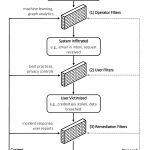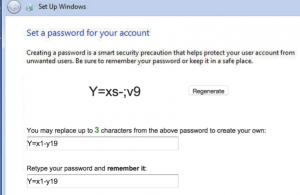 Current smartphone operating systems regulate application permissions by prompting users on an ask-on-first-use basis. Prior research has shown that this method is ineffective because it fails to account for context: the circumstances under which an application first requests access to data may be vastly different than the circumstances under which it subsequently requests access. LERSSE’s Primal is leading the research collaboration with UC Berkeley, in which a longitudinal 131-person field study was performed to analyze the contextuality behind user privacy decisions to regulate access to sensitive resources. Continue reading
Current smartphone operating systems regulate application permissions by prompting users on an ask-on-first-use basis. Prior research has shown that this method is ineffective because it fails to account for context: the circumstances under which an application first requests access to data may be vastly different than the circumstances under which it subsequently requests access. LERSSE’s Primal is leading the research collaboration with UC Berkeley, in which a longitudinal 131-person field study was performed to analyze the contextuality behind user privacy decisions to regulate access to sensitive resources. Continue reading
Author Archives:
Predicting Smartphone Users’ Permission Decisions
“I Don’t Use Apple Pay Because It’s Less Secure …”
 This paper reports on why people use, not use, or have stopped using mobile tap-and-pay in stores. The results of our online survey with 349 Apple Pay and 511 Android Pay participants suggest that the top reason for using mobile tap-andpay is usability. Surprisingly, for nonusers of Apple Pay, security was their biggest concern. A common security misconception we found among the nonusers (who stated security as their biggest concern) was that they felt storing card information on their phones is less secure than physically carrying cards inside their wallets. Continue reading
This paper reports on why people use, not use, or have stopped using mobile tap-and-pay in stores. The results of our online survey with 349 Apple Pay and 511 Android Pay participants suggest that the top reason for using mobile tap-andpay is usability. Surprisingly, for nonusers of Apple Pay, security was their biggest concern. A common security misconception we found among the nonusers (who stated security as their biggest concern) was that they felt storing card information on their phones is less secure than physically carrying cards inside their wallets. Continue reading
Social Insider Attacks on Facebook
 Facebook accounts are secured against unauthorized access through passwords and device-level security. Those defenses, however, may not be sufficient to prevent social insider attacks, where attackers know their victims, and gain access to a victim’s account by interacting directly with their device. To characterize these attacks, we ran two MTurk studies. In the first study Continue reading
Facebook accounts are secured against unauthorized access through passwords and device-level security. Those defenses, however, may not be sufficient to prevent social insider attacks, where attackers know their victims, and gain access to a victim’s account by interacting directly with their device. To characterize these attacks, we ran two MTurk studies. In the first study Continue reading
“I’m too Busy to Reset my LinkedIn Password”
 A common security practice used to deal with a password breach is locking user accounts and sending out an email to tell users that they need to reset their password to unlock their account. This paper evaluates the effectiveness of this security practice based on the password reset email that LinkedIn sent out around May 2016, and through an online survey conducted on 249 LinkedIn users who received that email. Our evaluation shows that only about 46% of the participants reset their passwords.
A common security practice used to deal with a password breach is locking user accounts and sending out an email to tell users that they need to reset their password to unlock their account. This paper evaluates the effectiveness of this security practice based on the password reset email that LinkedIn sent out around May 2016, and through an online survey conducted on 249 LinkedIn users who received that email. Our evaluation shows that only about 46% of the participants reset their passwords.
Going After Vulnerable Population to Defend It
 The orthodox paradigm to defend against automated social-engineering attacks in large-scale socio-technical systems is reactive and victim-agnostic. Defenses generally focus on identifying the attacks/attackers (e.g., phishing emails, social-bot infiltrations, malware offered for download). To change the status quo, we propose in our paper presented at NSPW ’16 to identify, even if imperfectly, the vulnerable user population, that is, the users that are likely to fall victim to such attacks. Once identified, information about the vulnerable population can be used in two ways. Continue reading
The orthodox paradigm to defend against automated social-engineering attacks in large-scale socio-technical systems is reactive and victim-agnostic. Defenses generally focus on identifying the attacks/attackers (e.g., phishing emails, social-bot infiltrations, malware offered for download). To change the status quo, we propose in our paper presented at NSPW ’16 to identify, even if imperfectly, the vulnerable user population, that is, the users that are likely to fall victim to such attacks. Once identified, information about the vulnerable population can be used in two ways. Continue reading
Investigation of Phishing Avoidance
 This paper reports on a design and development of a mobile game prototype as an educational tool helping computer users to protect themselves against phishing attacks. The elements of a game design framework for avoiding phishing attacks were used to address the game design issues. Our mobile game design aimed to enhance the users’ avoidance behaviour through motivation to protect themselves against phishing threats. Continue reading
This paper reports on a design and development of a mobile game prototype as an educational tool helping computer users to protect themselves against phishing attacks. The elements of a game design framework for avoiding phishing attacks were used to address the game design issues. Our mobile game design aimed to enhance the users’ avoidance behaviour through motivation to protect themselves against phishing threats. Continue reading
What I Love About My Research
As part of Innovate (in October) 2015, I gave a 7-minute “edutainment” talk, explaining in a very accessible form my current research, using an example of a recent study of iPhone’s TouchID:
Findings on Touch ID in plain (British) English
My research group had a paper presented at SOUPS on the interplay between TouchID and iPhone security, which I’ve described in a recent post. Here’s a video made by a wonderful team at Kindea Labs that explains the key findings in language accessible virtually to anyone:
Towards strong and memorable passwords
 System-generated random passwords have maximum password security and are highly resistant to guessing attacks. However, few systems use such passwords because they are difficult to remember. In this paper, we propose a system-initiated user-replaceable password scheme called “Surpass” that lets users replace few characters in a random password to make it more memorable. Continue reading
System-generated random passwords have maximum password security and are highly resistant to guessing attacks. However, few systems use such passwords because they are difficult to remember. In this paper, we propose a system-initiated user-replaceable password scheme called “Surpass” that lets users replace few characters in a random password to make it more memorable. Continue reading
Android Rooting: Methods, Detection, and Evasion
 User root their Android (or jailbreak their iPhone) smartphones. They do so in order to run useful apps that require root privileges, to remove restrictions by carriers and hardware manufacturers, and to alter or remove system apps. Rooted devices are prevalent. According to a recent Android security report, Google Verify Apps detected rooting apps installed on approximately 2.5M devices.
User root their Android (or jailbreak their iPhone) smartphones. They do so in order to run useful apps that require root privileges, to remove restrictions by carriers and hardware manufacturers, and to alter or remove system apps. Rooted devices are prevalent. According to a recent Android security report, Google Verify Apps detected rooting apps installed on approximately 2.5M devices.
